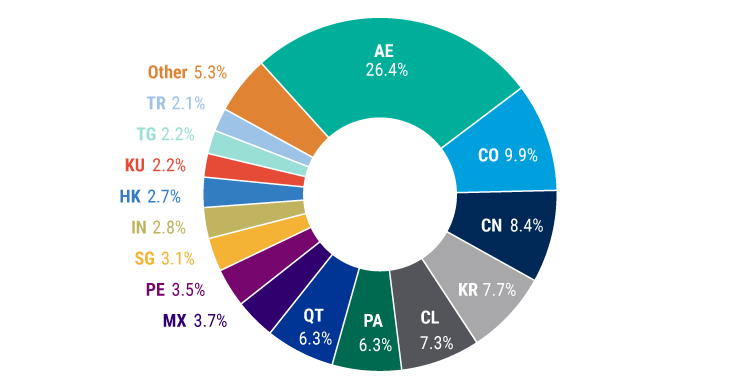Strong Emerging Market Banks Reflect Underlying Financial Stability

Jonathan Davis
Client Portfolio Manager and Sustainable Investment Strategist – Emerging Markets Fixed Income

Janine Miller
Credit Analyst
While rate cuts have reduced the profitability of banks across EM, these cuts factor into a stable economic outlook that supports loan quality and liquidity across the EM banking system.
China’s banks are not highlighting a major change in outlook despite tariff risks, and non-performing real estate loans have stabilized and started to drop, part of an overall trend of strengthening capital positions.
Investment grade banks in EMEA have seen net interest margins weaken due to monetary policy easing, but the forecast is for the pace of NIM compression to decline.
In Latin America, the region’s banks are solidly capitalized and with sound asset quality metrics.

Changes in US trade policy have unleashed historic levels of uncertainty regarding global growth, inflation, and monetary policy, all of which make the operating environment for the global financial sector much less predictable. Nevertheless, the banking sector across emerging markets is generally well-positioned to withstand downside risks within the global economy.
Of course, given the various stages of development and vastly different drivers for each emerging market region and country, comparisons are imperfect. But if we drill down within regions and market segments, we can make some characterizations for how the sector’s outlook has been evolving.
Our EM Corporate team recently reviewed all 121 financial names under coverage across 29 countries to examine how the industry outlook has shifted over the last year and potential impacts from elevated global economic uncertainty. Overall, banking profitability across EM has been reduced by rate cuts. However, those rate cuts factor into a stable macroeconomic outlook that supports loan quality and liquidity across the EM banking system.
Exposure of Financial Sector by Country

Source: J.P. Morgan and PineBridge Investments as of 31 March 2024.
China’s banks face tariff risks while the rest of Asia watches rate-cut moves
In Asia, the financials sector is large and covers multiple countries, so drawing conclusions across the board is a challenge. China is not only a main driver of regional activity but is also the country most exposed to US tariff policy, and where we see the most headlines. The trade war with the US will reduce economic growth and inflation in China, which we expect will prompt increased fiscal support and monetary policy easing, which will challenge banks’ profitability.
To date, Chinese banks are not highlighting any major change in outlook despite tariff risks. Non-performing loans (NPLs) in real estate have stabilized and started to decline, part of an overall trend of stable NPLs and strengthening capital positions for China’s banks. We are, of course, wary of an increase in NPLs as US trade freezes and exports need to be rerouted. We are also cautious of risks that Hong Kong commercial real estate may pose for local banks. We expect the easing of monetary policy to continue, which will keep putting pressure on net interest margins (NIMs).
In Korea, rate cuts by the Bank of Korea will dent profitability for the banking sector. While NIM contraction affects the banks’ top lines, prudent risk management and stable credit trends within lending portfolios is supportive of the banking sector.
Meanwhile, the Reserve Bank of India (RBI) rate cut cycle is putting pressure on NIMs, but we view this as a cyclical adjustment and not a structural change. Asset quality is a concern for microfinance institutions and consumer loans, though large banks are less exposed to risks within the lower market segment. Higher delinquencies are also viewed as a cyclical risk, not a structural deterioration.
Elsewhere, the Thai, Malaysia, and Singaporean banks have strong loan books and balance sheets. Loan growth has been low, as the banks are very conservative. In Indonesia, profitability continues to be high, ensuring capital levels are solid even with strong loan growth. In the Philippines, banks are shifting focus toward lending to higher-yielding, riskier segments to boost profitability, and the riskier loan books may lead to increased provisioning.
EMEA banks expect net interest margin pressures to ease
In emerging Europe, the Middle East, and Africa, the investment grade banks have seen NIMs weaken on monetary policy easing, but the forecast is for the pace of NIM compression to decline. In the Middle East, large, government-sponsored banks have pricing power to protect revenues despite tighter NIMs. The economic insulation in the Middle East is supportive of asset quality, and tight quality standards and abundant liquidity all reduce risks in the sector.
In Turkey, banks operate in a higher-risk environment than in the Middle East, but the outlook is favorable. The banks are seeing a strong recovery of NIMs this year given asset/liability repricing, with profit gains that outweigh the higher cost of risk and lower fee income. In 2025, while we expect tighter fiscal policy to slow growth to 2.5%, monetary policy will remain tight enough to continue the rebalancing. Loan growth remains subdued, though we continue to watch foreign exchange (FX) loan growth, which picked up in January and February and could bring upside risk to our inflation and growth forecasts. The sector’s outlook has become more positive over the past few quarters, and guidance is for a reduction in NPLs and overall stronger loan books based on appreciation of the Turkish lira, policy rate easing, and economic recovery.
In Africa, we have two areas under coverage: multi-national development banks (MDBs) and regional banks. The MDBs have been raising capital to meet the demands of solid loan growth, and the stabilization of Fed rates above trend supports profitability. African banks are sensitive to macroeconomic conditions, but a modest slowdown in global growth does not derail high profitability for African banks. The outlook is positive, as the Sub-Saharan African markets are extremely profitable, so stabilization is all that’s required to drive improving fundamentals. US development aid cuts may cause some weakness in operating regions, but it is not expected to be material.
A potential risk on the horizon would be further withdrawal of the US from international finance institutions (IFIs) such as the International Monetary Fund (IMF) and World Bank. While the MDBs in our coverage do not have the US as a shareholder, US withdrawals from global MDBs, such as the World Bank, may indirectly prompt these MDBs to cut back on lending. This may reduce availability of funding to select countries that depend on their loans, which could in turn raise loan quality risks for African MDBs that lend to the same countries. On the other hand, withdrawing of IFI lending may raise loan growth prospects for African MDBs.
Latin American banks can weather the impact of US policies
In Latin America, monetary policy divergence among central banks is a core theme that will impact bank performance, but loan quality across the region is stable. In Chile and Peru, the economic growth recovery story supports loan quality and a stabilization of policy rates, which improves NIMs. In Mexico, the banks have shown resilience in asset quality despite slower economic activity. We expect an acceleration of rate cuts that will reduce NIMs, as Banxico maintains the conviction that inflation has passed and will look to offset negative growth risks. However, an offset is that regulatory risks have declined for the sector.
Brazil’s economy, meanwhile, has diverged from the lower-inflation, lower-rates trend seen across the rest of LatAm, as increased inflation has driven central bank rate hikes, which are expected to be a substantial drag on growth. Lower growth and higher rates in Brazil will lead to deterioration of corporate and household balance sheets and a likely increase in non-performing loans. Consequently, banks have cut their guidance for loan book growth from the high single-digits last year to mid-single-digits this year.
We see potential for volatility related to US trade policy, particularly with Mexico, whose economy is highly dependent on US exports. However, for now Mexico is subject to one of the lowest US tariff rates, as many USMCA-eligible goods have been exempted from the universal 10% tariff. Latin America has avoided the more punitive reciprocal tariffs that loom for a number of US trading partners, with the impact limited to the 10% universal tariff and secondary effects of changes in global growth, inflation, foreign exchange, and commodity prices. The region’s financial sector is well insulated, its banks solidly capitalized and with sound asset quality metrics. Regulatory oversight is strict, with significant capital requirements on the largest systematic banks.
Emerging market banks are in a solid position to withstand uncertainty
Overall, we believe that while the global environment is undoubtedly more uncertain than it was a year ago, EM economies are generally in good shape, and the banking sector reflects that stability. Our review has underscored that while bank profitability may be lower given recent rate cuts, asset quality remains stable, providing investment opportunities that are less impacted by global trade uncertainty.
Disclosure
Investing involves risk, including possible loss of principal. The information presented herein is for illustrative purposes only and should not be considered reflective of any particular security, strategy, or investment product. It represents a general assessment of the markets at a specific time and is not a guarantee of future performance results or market movement. This material does not constitute investment, financial, legal, tax, or other advice; investment research or a product of any research department; an offer to sell, or the solicitation of an offer to purchase any security or interest in a fund; or a recommendation for any investment product or strategy. PineBridge Investments is not soliciting or recommending any action based on information in this document. Any opinions, projections, or forward-looking statements expressed herein are solely those of the author, may differ from the views or opinions expressed by other areas of PineBridge Investments, and are only for general informational purposes as of the date indicated. Views may be based on third-party data that has not been independently verified. PineBridge Investments does not approve of or endorse any republication of this material. You are solely responsible for deciding whether any investment product or strategy is appropriate for you based upon your investment goals, financial situation and tolerance for risk.




